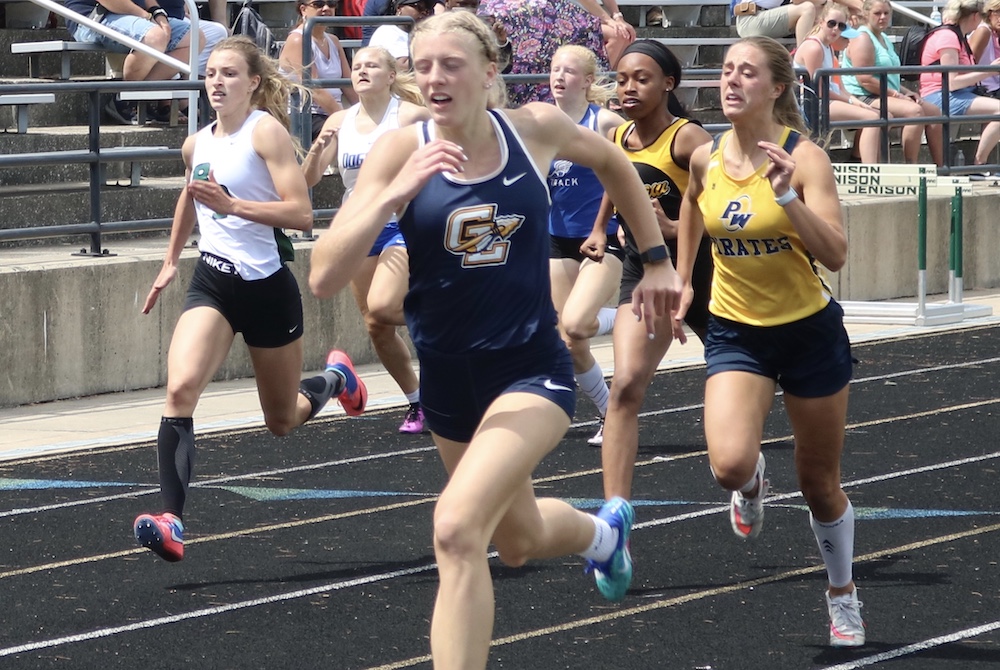
Tie Nets P-W Girls Repeat, Grass Lake's 1st Title Since 1978
By
Tim Robinson
Special for MHSAA.com
June 6, 2021
JENISON — Grass Lake coach Anthony Cole and Pewamo-Westphalia mentor Scott Werner had a dilemma after their teams tied for the Lower Peninsula Division 3 team championship Saturday.
It boiled down to this: Co-champions, but only one trophy available.
They settled it in a classic fashion: Rock, Paper, Scissors.
Even though there was a bit of orientation, first “We had to figure out how to do it,” Werner said. “We had to get into sync first, and it came down to best two out of three. And, fittingly, it came down to the last one.”
In this case, Werner’s paper covered Cole’s rock, and the Pirates went home with the trophy.
It was about the only disappointment the Grass Lake team suffered on the day as the Warriors also won the boys title.
Pewamo-Westphalia led most of Saturday, but the Warriors forged the tie when its 1,600 relay team, anchored by Lexie Bargesser, finished second in that event.
 It was Grass Lake’s first MHSAA title in girls track & field since winning back-to-back Class D championships in 1977 and 1978, while it was the second in a row for the Pirates, who won the team title in 2019.
It was Grass Lake’s first MHSAA title in girls track & field since winning back-to-back Class D championships in 1977 and 1978, while it was the second in a row for the Pirates, who won the team title in 2019.
“We’re so happy to be back,” Werner said. “We had a team we thought was good enough to win it last year, too.”
It was the fifth girls title overall for Pewamo-Westphalia, which has finished first or second at five of the last eight Division 3 state meets.
“We like being on that podium,” Werner said, grinning.
Depth played a role for the Pirates.
Senior Sophie Thelen finished third in the 100, second in the 200, third in the pole vault and was on the 800 relay that finished fourth. Freshman Saige Martin had a big day, taking second in the 100 hurdles and third in the 300 hurdles.
“We also scored in some relays,” Werner said. “It was all over the board. Everyone stepped up."
Cole was pleased and a little surprised by his team’s performance.
“If you had told me (Friday) that we would do this today and our kids would perform the way they did, I would have probably laughed,” Cole said. “It was a nice surprise. We knew it would be close. The girls took care of business all day, and sure enough, we were there. Co-champs isn’t bad."
The Warriors were happy to share, and Bargesser played a key role Saturday, winning the 100, 200, and the 400 (in record time) while also anchoring the 1,600 relay that finished second.
Kailee Sandoval also had a big day,
“She ran an outstanding 800 in this heat, and ran a great leg to start the 4x400 relay,” Cole said. “She ran her butt off. It was her senior meet, and she left it all out there. I’m so happy for her.”
Byron finished third on the strength of record-setting performances by senior Sarah Marvin and a strong performance by fraternal twin Becky, both in the throwing events.
Sarah Marvin set a Lower Peninsula Division 3 mark in the discus at 160 feet even and set an all-Finals record in the shot put with a throw of 50 feet, 9½ inches, making her the first high school girl in Michigan to throw for 50 or more feet at the state meet. She missed setting an all-meet record in the discus by 3 feet, 9 inches.
“I would have liked to have broken the MHSAA record,” she said. “But I’m so happy to have (the Division 3) record.”
She was just as happy for her sister, who had personal bests in the shot and discus.
“She wanted a second (place) and a second, but all you can do is be better than yourself, and she did that in both events,” Sarah Marvin said of her twin. “I think it was a fantastic day for her.”
It also was a fantastic day for Ithaca junior Lani Bloom, who won the 800 in 2:13.67 and the 1,600 in a meet record 4:48.89. Mason County Central's Nyah Tyron swept the hurdles races with a 15.36 in the 100 and 45.01 in the 300.
But as for regrets, Cole had one on what was a pretty good day for his team.
“I’m pretty hyper-competitive,” he said, grinning. “I should not have thrown rock that third time. I’m usually a scissors guy, but I went rock and (Werner) threw paper for the third time. I just couldn’t believe it.”
And then he joined his team, beaming at their accomplishment.
PHOTOS: (Top) Grass Lake's Lexie Bargesser crosses first with Pewamo-Westphalia's Sophie Thelen right behind in one of their races together Saturday. (Middle) Byron's Becky and Sarah Marvin show their medals after dominating the throws. (Photos by Tim Robinson.)

Track Gaining Speed Toward Future with Electronic Starting Devices
By
Steve Vedder
Special for MHSAA.com
May 23, 2023
Aubrey Greenfield thinks it might be the perfect time to reevaluate 130 years of tradition.
For a number of reasons, from technical to personal, the Oxford senior sprinter believes it makes sense for the crack of a starting pistol to be eliminated from high school track meets.
Because track meets would benefit in various ways from lowering costs to easier setup at meets to the human factor of competitors not having to flinch at the crack of a pistol shot, Greenfield believes the sport has a chance to embrace new technology – electronic starting devices (ESD).
In essence, an ESD replaces the starting pistol with a light flash, tone sound or both to begin a race.
"High school sports should put the athlete first," Greenfield said. "We should promote sports, and eliminating starting pistols promotes health in terms of PTSD or trauma for athletes and spectators and that would be good. I would like to think people would say that's a good idea."
In fact, Greenfield would go as far as to say if there was not an implementation of electronic starting devices, many of her teammates would have considered giving up the sport.
"If it's something that helps us compete safely, we're all for it," she said.
Greenfield's opinion apparently is spreading. Michigan High School Athletic Association senior assistant director Cody Inglis said the use of ESD makes it both affordable for meet starters and sensible for athletes and fans to rethink the use of starting pistols. While the MHSAA is not mandating electronic starting devices, it does promote the use of what Inglis calls "emerging technology." He notes that ESD are becoming the norm for organizations such as USA Track & Field, the NCAA and an increasing number of high schools.
 "I think we have to embrace new technology, and we think this will be something that takes hold," Inglis said.
"I think we have to embrace new technology, and we think this will be something that takes hold," Inglis said.
A key part of embracing ESD is the human element. The tragic Oxford High School shooting Nov. 30, 2021, that took the lives of four students while injuring seven others should not be relived even for a fleeting instance at a high school sporting event. Oxford athletic director Tony DeMare said the school began using ESD at every meet, including the MHSAA Lower Peninsula Division 1 Finals last June. He said that decision was embraced by virtually all schools Oxford encountered.
"We were very convinced that the alternative (of ESD) would promote a healthy attitude," DeMare said. "We were overwhelmed with the positive response. If a school was on the fence about it or might not be for it, I think we've started to see the tide turn in favor of people willing to listen and learn about electronic starting devices."
Inglis said the MHSAA is acutely aware of what the crack of a starting pistol can mean to athletes and fans.
"It's unimaginable what Oxford went through, and this is a small way we can help," he said. "We look at a (starting pistol) and think, ‘Could we do something else?’ It's a way of helping to solve a problem."
Over the last several years, the MHSAA has embraced finding an alternative to starting pistols. Inglis noted the discussion started with the cost and diminishing availability of 32-caliber ammunition that meet starters use. A box of ammunition, if it can be found, is around $75 a box.
In addition to cost, there is potential damage from excessive exposure to 150-plus decibels of sound generated by the traditional 32-caliber blanks. Medical studies show damage to ears caused by decibel levels above 120 dB.
The tragedy at Oxford accelerated the conversation.
Inglis said the cost of ESD can be likened to a school sinking money into artificial surfaces at football fields. Yes, there is a great cost at first, but over time money is ultimately saved. An ESD system itself ranges between $200 and $500. Speakers also may need to be purchased, but with ESD starting events like the 800 and 1,600-meter relays positioned near the outside lanes 8, 7, 6 and 5 would result in improved hearing by athletes at the start of a race.
There is one challenge with ESD that track administrators are working to overcome – lighting conditions that lessen the ability to see the ESD’s LED light or strobe when the button is pressed by a starter to begin a race. But that vision difficulty resulting from clear blue skies and backgrounds of setting suns can be substantially improved by incorporating a black background with an ESD – something as simple as a starter holding up black cardboard behind the lighting mechanism at the start of an event.
Inglis said when all factors are considered, the use of ESD makes sense.
 "With the climate we live in nowadays, no lookalike guns is good," he said. "We're not mandating this. But people are saying this is affordable."
"With the climate we live in nowadays, no lookalike guns is good," he said. "We're not mandating this. But people are saying this is affordable."
While switching to ESD would break 130 years of tradition, the timing could be a step forward, said Jeff Hollobaugh, co-author of the book "The Fleet Feet of Spring: Michigan's High School State Championships in Track & Field." He said while no definitive answer is possible, it's likely starting pistols were used at the inaugural state meet at the Jackson Fairgounds in 1895. The meet, which included events like tossing a 16-pound shot put, bike races and a 100-meter sprint, was sponsored by the Michigan Interscholastic Athletic Association (a predecessor to the MHSAA) and comprised mostly of the state's larger schools.
Hollobaugh's sentiments echo what many involved in today's high school track & field believe in terms of making a transition from starting pistols to electronic starting devices.
"It's a change, not necessarily good or bad, just different," he said. "It's not a drastic change, but it will take some getting used to. But it is the future. In the end, we'll all be fine."
DeMare believes the future of high school track will definitely include ESD.
"Our desire is that the practicality and sensibility of this will overcome the alternative," he said. "I think we'll see the automation and electronics taking hold of certain elements in track, and people will embrace it."
PHOTOS (Top) Runners watch official Bertha Smiley as they prepare to begin a race during last season's Lower Peninsula Division 1 Finals at Rockford. (Middle) An electronic starting device provided by VS Athletics was used to start those races. (Below) Smiley sets to begin an event. (Photos provided by David Kuderka/VS Athletics.)

